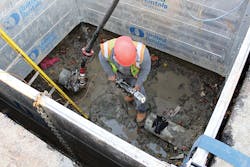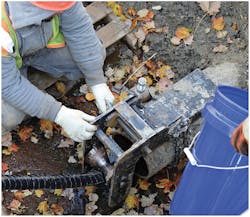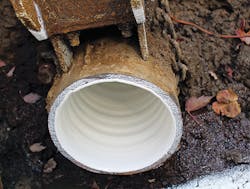Maintaining infrastructure assets such as water mains in fit-for-purpose condition is a critical component of utility management. However, as a community’s water infrastructure ages, its many buried pipes approach the end of their useful life. The incidence of leaks and water main breaks escalates, causing disruption to consumers and the local economy, and resulting in increases in water loss and in costly repairs.
Pipe asset management programs have become increasingly important, as they help communities optimize these assets and their annual pipe renewal budget. Advanced solutions such as the use of spray-in-place pipe rehabilitation provide an alternative to traditional dig-and-replace pipe or direct replacement, and offer a new tool to extend the life of existing pipes.
The city of Wyandotte is located approximately 11 miles south of Detroit in southeastern Michigan. Situated on the Detroit River — its water source — it is part of the collection of communities known as Downriver. In 1867, the village of Wyandotte, a flourishing industrial community, was incorporated as a city. Residents created the Wyandotte Municipal Water Utility 22 years later to provide fire protection and a convenient, safe source of drinking water.
Today, Wyandotte is the only Downriver community that owns and operates a potable water filtration plant. The Wyandotte Municipal Water Plant, which serves over 12,000 customers, can produce up to 15 million gallons of water per day. Its distribution system consists of 110 miles of water mains ranging from 4 inches to 30 inches in diameter. A total of 850 fire hydrants throughout the community provide fire protection. The water system has a 500,000-gallon elevated storage tank and 4.5 million gallons of ground level storage for peak demand periods such as fighting fires or other emergencies. The utility has annual revenues of over $3.5 million and sells over 1.5 billion gallons of water annually.
According to Bill Weirich, superintendent of the Wyandotte Water Department, the utility’s traditional method of maintaining the water mains was open-cutting and direct replacement, which requires trenching the entire length of pipe to be repaired or replaced and laying down new pipe in the trench. The downsides of this method are the high cost, the lengthy time involved in the process, and the disruption and inconvenience that customers encounter.
Another difficulty facing the open-cut and direct replacement method in Wyandotte was the presence of underground utilities. “Having all the other utilities underground makes it almost impossible to relocate your mains without running into gas and electric, and we also have underground cable,” Weirich said.
Wyandotte already contracted with SUEZ to provide water tower maintenance through its Asset Management Program when Weirich heard about the company’s trenchless and turnkey process called spray-in-place pipe rehabilitation solution (SIPP).
SUEZ’s SIPP solution uses a computer-controlled, robotic spray application rig to apply an NSF 61-approved, 100 percent-solids epoxy pipe lining in situ, requiring far less time than trenching and causing minimal disruption. “We started looking into SIPP and decided to give it a try on small areas and see what happened,” he recalled.
At Weirich’s suggestion, Wyandotte elected to use this system for pipe maintenance in the older part of the township. With aging cast iron pipes that dated back to the 1930s through 1950s, this area had experienced numerous water main breaks and faced the potential for more. Through the SIPP process, Wyandotte intended to remediate the aging infrastructure through SIPP with the goal of extending the life of the pipes by another 50-75 years.
HOW SIPP WORKS
SUEZ’s SIPP rehabilitation process consists of five steps for the restoration of aging underground systems, for most piping infrastructures:
- System analysis that includes mapping the system, utilizing CCTV to evaluate digitally recorded findings and then diagnose and identify a restoration plan.
- Preparation of the pipe interior by drag scraping, power boring and/or hydro-jetting to create a clean, smooth dry surface. This is followed by a second CCTV inspection to determine if there are any leaks, infiltration, or repairs that are needed outside of the SIPP scope of work.
- Repair of any current piping issues and then prep for the epoxy coating.
- Epoxy lining and reassembly.
- Final inspection and system analysis, including thorough inspection of the epoxy lining and chlorination/disinfection before system restoration.
SUEZ uses state-of-the-art robotic spray application rigs, which are computer-controlled for more refined application and curing, to apply the internal epoxy lining. Once cured, this coating creates an internal seal that prevents leaks and helps protect against future corrosion and biological buildup. This extends the pipes’ service life, helps reduce the frequency of maintenance, and increases the flow capacity for greater system efficiency.
Because the epoxy coating bonds with the pipes, it also seals cracks and protects against the formation of future infiltration. In addition, the coating elasticity means the newly applied lining is flexible and moves with the pipe, thus reducing the risk of leaks caused by infrastructure settling.
Another benefit is that the epoxy lining that seals restored pipeline systems may eliminate leaching of lead from soldered joints and the corrosion of copper and steel pipe, thus significantly improving water quality. The two-component 100-percent-solids epoxy system used by SUEZ to coat water distribution systems meets ANSI/NSF 61 standards. Epoxy is a zero-VOC material with certified zero fish kill.
Weirich described how the process worked on the section of pipes marked for the SIPP. “We took some main on which we had about 10 to 15 repair clamps. We did three parts of the system: a four-inch pipe and two six-inch pipes. With the SIPP program, we were able to open up three holes to remediate the pipes rather than open-cut the whole area and replace the main,” he said.
After locating the pipe next to a valve on each end, SUEZ inserted a receiving pit for the robotic device that applied the epoxy coating. After one section was done, the valve was replaced, and spraying of the lining continued down the line to the next valve, and so on.
“In essence, we were lining the pipe and putting in two new operational, more up-to-date valves to replace the older ones that dated back to the 1950s,” Weirich noted. “This gives us a more reliable way to shut the system down. And by sealing the inside of the pipes, I think we’ve greatly reduced the likelihood of main breaks in that area.”
One issue surfaced during the process due to Wyandotte’s high water table, but it was quickly dealt with. “There were some issues with running into water. When the pipe was being scraped and cleaned, we had infiltration from the ground. However, once we worked that out and put an internal sleeve inside the pipe to stop the water, the pipe lining went smoothly,” said Weirich.
RESULTS
According to Weirich, the SIPP program has yielded numerous benefits.
“In all, Wyandotte rehabbed approximately 3,500 feet of main in only about one month. If we would have open-cut that, we would probably have been working on it all summer,” he said. He also noted, “We were getting only about 1,500-2,000 feet for the same amount of money with the open-cut method.
“When we talk about cost savings with SIPP, we compare it to traditional dig-and-replace pipe, or direct replacement, where you dig up the entire length of the pipe that needs attention and replace it all. That causes a lot of disruption, whether you’re digging up a roadway, someone’s yard, driveway, and so forth. We estimate that, on average, SIPP can yield a cost savings of around 20 to 30 percent when compared to direct replacement,” he said.
Weirich also noted a benefit that transcended cost: the ability to minimize inconvenience to consumers by using SIPP rather than open-cut and direct replacement. “I look at SIPP as being unobtrusive to the customer because you are not creating a major construction zone. If you can run your temporary lines without blocking off the ends of the streets, that helps, as our customers have access to their homes. We try as muchas we can not to inconvenience our customers.”
Because it is a trenchless technology application, SIPP requires only two access points: the first point, where the equipment is inserted, and the second at the other end of the segment — the discharge — where equipment is, in essence, attached and pulled through. And because only very small access cuts are required, disruption is minimal. There isno need to dig up the whole length of the road. SIPP is great for applications underneath railroads, interstates, highways, buildings and so forth. That provides a huge benefit to communities and their customers.
“I believe we were the first water department in Michigan to use SIPP,” Weirich added. “That’s why we started small, so we could make sure that the process was going to work. We took a worst-case scenario to see how this would work. Going forward, we’re going to expand on where we started and begin expanding out to the whole system from those three points.”
About the Author
Chad Atcheson
Chad Atcheson is responsible for managing the Network Asset Management line of business for SUEZ. With eight years’ experience in the piping industry, he specializes in pipe rehabilitation, condition assessments and trenchless technology. He holds a M.S. in civil engineering with a focus on environmental engineering
from Auburn University.


